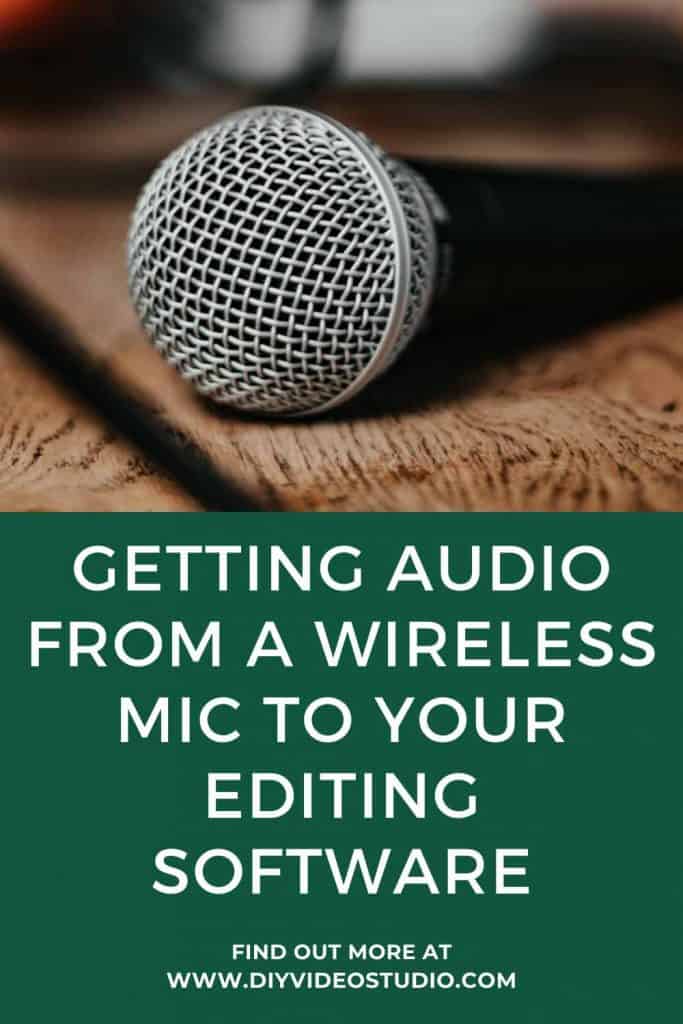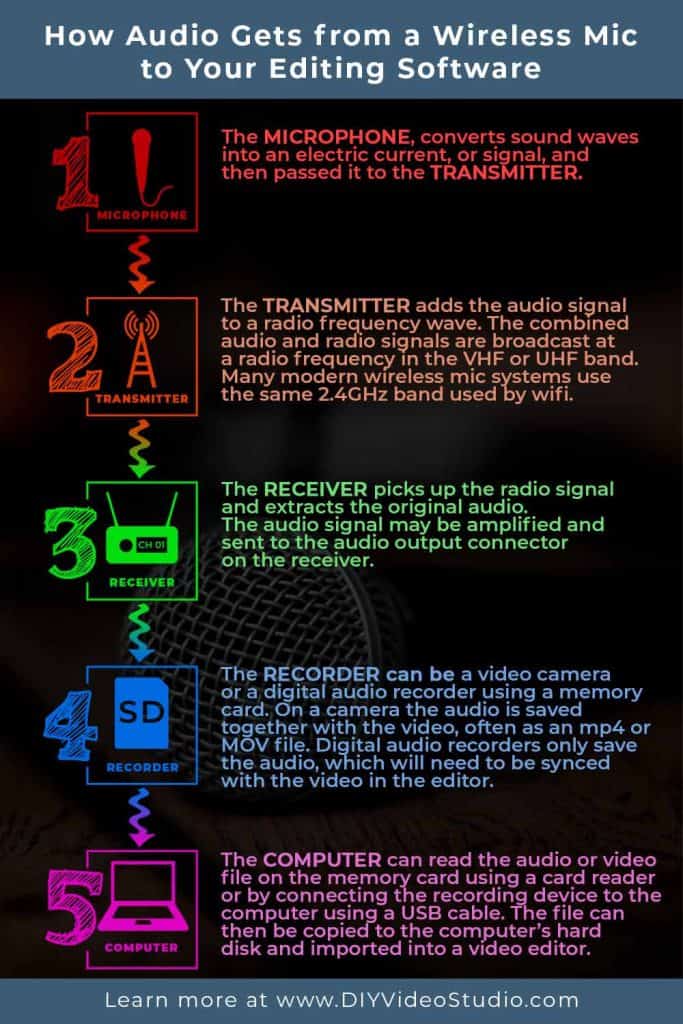How Do I Upload Audio To Computer Lapel Mic Rodelink
DIY Video Studio is supported past its readers. Please assume links on this site are affiliate links, and that I get commissions for purchases made through these links. As an Amazon Acquaintance I earn from qualifying purchases. It helps me pay for the running of this website. Cheers if you use any of the links, nosotros really appreciate information technology!
Unless you're a professional videographer or audio engineer, understanding how to use a wireless microphone with your video camera can puzzling. Information technology would be like shooting fish in a barrel if there was only one type of microphone, one type of wireless system, and one blazon of video recorder. With so few options it would be like shooting fish in a barrel-peasy-lemon-squeezy to fit everything together and go it working. Just we all know life's not like that. And then, if wireless mic audio isn't intuitive for everyone, why should nosotros bother with it?
By using wireless mic audio, we can record good quality audio and video together, without the need for a cable connexion betwixt the microphone and camera. The freedom of motility this allows is something many filmmakers capeesh. That is specially true when recording with a physically active presenter, such every bit an exercise class teacher, who demonstrates while explaining.

Now stay with me and I'll explain how wireless mic sound works and how yous can put it to skilful use, even if you're non a yoga teacher.
LOOKING FOR A WIRELESS MIC SYSTEM? Here are our recommended systems for vloggers, filmmakers, and places of worship. You tin can exist bodacious we just choose the best products…
Last update on 2022-06-xiii / Affiliate links / Images from Amazon Product Advertising API
How practise wireless microphones work?
A wireless microphone works is by capturing sound with a microphone, encoding the audio signal, before broadcasting information technology using a minor radio transmitter. The radio signal is picked-up and the sound decoded on a radio receiver that is connected to a video photographic camera, where the audio is added to the video footage and recorded to a memory card as a video file.
The video file can be copied to a reckoner and then imported into an editing plan.
The in a higher place scenario assumes you are using a wireless microphone with a video camera, merely if yous are using a wireless microphone for a video event, such as a concert, seminar or business presentation, the wireless receiver volition plug directly into a audio mixing desk or PA organisation.
That's an overview of how a wireless mic works, just nosotros'll take a closer wait, at each stage in the wireless microphone process and then the hardware used for each stage.
Step i: Microphone captures the sound

The sound we hear is the event of pressure waves in air striking our eardrums and making them vibrate. The same process happens in a microphone. The sound waves strike a diaphragm, causing it to vibrate. This vibration is converted into an electric betoken.
The most pop microphone types of microphones are Dynamic and Condenser. Both types produce a varying electrical current, or signal, that represents those pressure waves we hear as sound. Still, they create the audio bespeak is 2 dissimilar ways.
In a dynamic microphone a curl of thin copper wire is attached to the diaphragm and sits in a magnetic field that'southward produced past a permanent magnet. Equally the diaphragm vibrates so does the roll. Now since a wire, in this case the coil, moving in a magnetic field generates a small electric current that electric current matches the sound vibrations, which can be passes on to an amplifier in the transmitter.
In a condenser microphone, the diaphragm forms part of an electrical capacitor. In fact, a condenser is an culling name for a capacitor. Equally the sound waves vibrate the diaphragm, the capacitance changes in line with the vibration. It'due south that irresolute capacitance that's used to create the electrical indicate that represents the audio.
Step two: Transmitter converts and broadcasts the bespeak

The electrical point generated past the microphone may be amplified and and so digitized into a digital point of ones and zeros. The indicate is then circulate in a specific office of a VHF or UHF spectrum.
Some transmitters may also apply 128-fleck or 256-bit encoding to make the signal secure. This ensures that if anyone else picks up the signal they will not exist able to admission the audio.
Footstep three: Receiver picks up and converts radio waves into an audio signal

The incoming radio waves cause a varying current in the receiver's antenna or antennas. This electrical signal contains the digital data, and the receiver "decodes" it, turning it dorsum into a regular sound electrical signal. This signal may be amplified before being sent to the receiver'south audio output. The output is and then connected to the device we want the audio indicate to get. In our scenario, we would plug in a recording device (Step four), but if you are streaming y'all would connect the receiver to a computer using an audio interface.
STEP 4: Recording device saves the audio signal to retentivity

The output from the receiver volition be recorded onto the device you lot're using for the audio. It's likely to exist the aforementioned device where you're recording the video. It could exist a DSLR/Mirrorless camera, smartphone, camcorder, or fifty-fifty a computer. On these devices the audio and video will be recorded to the same file, often an mp4 or MOV.
Alternatively, the audio could be recorded separately from the video using a digital sound recorder, such as Zoom's H1n, H4n, or H6 recorders. Typically, they save the sound every bit mp3 or wav files. For the highest quality, uncompressed wav files are used.
STEP v: The audio files are transferred to a calculator for editing

A Computer is normally where we want to put the video and audio files. This allows usa to edit and combine clips.
This could be just to tidy up our clips by trimming the beginning and cease. Or the editing can involve removing sections, moving effectually certain parts, or combining parts from several recordings.
In all cases we get the video and sound files onto the computer by either connecting the recording device to the computer using a USB file or inserting the devices memory card into the computer'southward carte reader. In some cases, you tin transfer the files over wifi, but quality audio and video files can exist big and wifi transfer impractical.
In one case the media files are on the computer'due south hard disk, they can exist imported into editing software.
The following infographic summarizes the five-pace process.

Parts of a wireless microphone audio system
Now we know how a wireless microphone system works, let's take a closer look at the individual component parts.
Microphone
Wireless microphones are about frequently of ii types: lavalier/headset mics and handheld mics.
Lavalier and Headset microphones are small and lite. The mic sheathing, the part that converts sound waves into a small electrical indicate, tin be a few millimetres to about a centimetre or 2 in size. This means they can hands be hidden on the speaker'due south body/clothing or worn on their caput. The big advantage lavalier and headset mics offering is that they allow the presenter to speak to the camera hands free.
Lavlier and headset mics use condenser mic capsules, this type of microphone may need power. On larger condenser microphones it's called phantom power.
Handheld wireless microphones look like regular microphones, with a ball grill or mesh over the elevation, under which a large microphone capsule is located. It is not unusual for the grill to be detachable. This allows them to exist cleaned (don't attempt cleaning the mic capsule).
Handheld mics normally apply dynamic mic capsules. Since the moving coil in a dynamic mic generates an electric current these mics don't need power to produce the sound betoken but, as yous will see, handheld wireless mics exercise demand batteries for the built-in transmitter. This explains why a handheld wireless mic is much larger and heavier than it'south lavalier counterpart, it also contains the radio transmitter and batteries.
Transmitter
The transmitter in a wireless microphone kit can be built into the mic (handheld), a split up function (lavalier/headset), or a clip-on cube that attaches to a regular professional XLR microphone. In each example the transmitter requires power.
The power on a wireless mic transmitter is provided past batteries. These tin can be rechargeable lithium-ion batteries that are sealed in the transmitter unit. Alternatively, they can exist rechargeable or conventional AA or PP3 batteries. I adopt the AA or PP3 type since they can quickly be swapped over if necessary, in the middle of a shoot. Transmitters with internally sealed Li-ion batteries must be put on charge, making them unusable for while they accuse.
On a handheld wireless microphone, you can slide open or unscrew the outer housing to reveal the controls. These can include the aqueduct or frequency selector, an audio level control, and an RF (radio frequency) power selector. The ON/OFF switch is usually on the base of the mic for easy access.
Lavalier and headset mics are small, and so the transmitter must exist a dissever unit. This unit is called a body pack or chugalug pack. These are clipped on to the presenter'due south belt or subconscious on their body or clothing.
Considering the mic and transmitter are separate, they are connected using a thin cable and connector. In more expensive and professional systems the connector screws or clicks onto the transmitter'south "audio-in" socket. This ensures the mic stays in place and won't go disconnected due to the presenter's movements.
Clip-on Cube transmitters are a more than recent innovation. Equally the name suggests, they look like a cube with an XLR connector sticking upward from the top. This allows it to exist used with professional XLR microphones, whether handheld reporter types or shotgun mics that are commonly used on nail poles in filmmaking and broadcast Television set. However, whatsoever other type of XLR mic can likewise be attached. So, if you want to use a vintage mic, no problem. Plug in a cube transmitter and you've got a absurd looking wireless microphone.
Receiver
Wireless receivers come in a couple of forms. These are large and mains outlet powered desktop or rack mounted units, and small battery-operated chugalug pack or photographic camera mounted units.
The desktop or rack mounted receivers are really for alive venues, corporate conventions, places of worship, etc. In other words, places where the setup is permanent or semi-permanent.
Chugalug pack and camera mounted receivers give the photographic camera freedom of motility, while recording the video and audio to the same file.
Depending on the wireless arrangement, the receiver tin be as much equally 100m (328ft) from the radio transmitter. Provided nothing has caused any interference, the betoken should exist the same as the signal leaving the transmitter.
Recording device
Your recording device is probably going to be your camera. In well-nigh cases, this would exist your ideal selection because the sound will be recorded to the same file as the video footage, just like your regular video clips.
You can use many different types of photographic camera to record your video and wireless mic audio together. These include camcorders or video cameras, DSLR/Mirrorless cameras, and fifty-fifty your smartphone.
Just at that place is a caveat hither. Your camera must have an audio input socket.
In this era of hybrid shooters, it'south surprising how many expensive DSLR and mirrorless cameras don't have audio in and mic out sockets. Some, like the Canon M50 have mic in sockets but no headphone socket to allow you to monitor the quality of the audio. At that place are solutions to the trouble, merely they add an actress complexity to the setup.
Professional person filmmakers often record audio on a split recorder to the camera, and that's also an option for you. You don't need hugely expensive digital recorders. I use a Zoom H4n or H6 recorder mounted on top of my photographic camera. This allows me to record from multiple microphones with the audio from each mic on a dissever runway. Still, you lot can get digital audio recorders for around one hundred dollars (such equally the Zoom Handy Recorder) that takes three.5mm jack.
If yous do tape your sound and video separately, i.e. the video on a video recorder and the sound on a digital audio recorder you will need to sync the audio and video together in your editing software.
Whatsoever recording device you utilize information technology will probably record to a retentiveness card.
Reckoner and editing software
The first step to editing video on your estimator involves getting the video footage onto your hd. You tin usually practise this past either connecting your recording device to your computer using a USB cable or by putting your memory card into your reckoner's card reader.
Whichever method you utilize exist prepared for the transfer to take a little time, especially if y'all have been recording 4k or 8K files. Your video files will be large, particularly if they are longer than 20 or 30sec.
Once on your computer try to put your video project on the fastest drive you have. If you have a choice between an SSD and a conventional hard disk drive, choose the SSD. Your read and write speeds volition be much faster, so your project will load more quickly in your editing software and the video previews will be smoother. All in all your editing experience will exist meliorate.
If you lot are non using Adobe Premiere Pro CC or Apple's Final Cutting and want to save yourself money without cutting your creative opportunities, there are two video editing apps you lot should consider. Both are cross-platform apps, powerful, and they're too free. What'due south not to like! They are HitFilm Express![]() and DaVinci Resolve 16
and DaVinci Resolve 16![]() .
.
Are wireless mics better than wired?
Wireless mics are better than wired mics if you lot need freedom of movement and to lessen the on-stage trip run a risk.
Typical examples where these factors may be desirable would be a concert or theatrical operation, a lecture, business seminar, product demonstrations, exercise classes, and in video product.
Wireless mics are also a good selection if you demand to conceal the microphone on the presenter. In this case a lavalier microphone tin can be attached underneath to the presenter'south clothing and the cable feed through to the transmitter body pack, which can be worn on a belt.
Yet, the microphones used in some wireless microphone systems are not as high a standard equally though yous might wait in a voiceover studio. This isn't to say they are in anyhow bad, it's but that high-quality condenser microphones are non robust enough to be used outside of a studio environment. None-the-less, you tin expect wireless microphones not to have as good a frequency response as wired microphones. Just to be honest, this isn't much of a problem.
Another downside of wireless mics is that they may suffer from radio interference or there may not exist enough frequencies available to run the number of mics you need.
In truth, the answer to whether wireless mics are better than wired mics is down to what are your requirements and budget. Both wireless and wired mics take their pros and cons, and so y'all must cull the type of mic that is right for your recording state of affairs. It'due south a case of picking the correct mic for the job.
Tosh Lubek runs an audio and video production business in the UK and has been using the Canon EOS R since it was released in the Autumn of 2018. He has used the camera to shoot Television set commercials for Heaven TV, promotional business videos, videos of events and functions, and YouTube creator content. He has too won international awards for his advertizing and promotional work. You can meet him by visiting his "video booth" at HashTag business events beyond the country.
Source: https://www.diyvideostudio.com/how-do-you-get-the-audio-from-a-wireless-mic-to-your-editing-software/
Posted by: hunterroomens.blogspot.com

0 Response to "How Do I Upload Audio To Computer Lapel Mic Rodelink"
Post a Comment